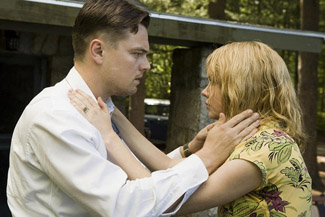She Said/He Said: Shutter Island
By Jamie D. Ruccio
March 4, 2010
Shutter Island is Martin Scorsese's latest film, based on the novel of the same name by Dennis Lehane. Lehane's previous novels, Gone Baby Gone and Mystic River, have become award winning, critically acclaimed films. The collaboration between Scorsese and Lehane seems a natural fit as the director, a New York City native, and the author, born and raised in a suburb of Boston, both draw from their urban upbringings to create works that explore how individuals struggle with morality in a modern setting, often times in urban environments. It was therefore an interesting pairing of two seemingly like-minded individuals who work in very similar worlds.
The film Shutter Island is set in 1954 as Federal Marshals Teddy Daniels (played by Leonardo DiCaprio) and Chuck Aule (played by Mark Ruffalo) are sent to investigate the mysterious disappearance of a patient, Rachel Solando, from Ashecliff Hospital for the criminally insane on Shutter Island. Rachel was institutionalized after having murdered her three children. This investigation is fortuitous for Agent Daniels as he believes Andrew Laeddis, the man who set fire to the apartment building where Agent Daniels and his wife lived and was therefore responsible for his wife's death, may also be a patient at Ashecliff Hospital. Agent Daniels also has conducted a long standing investigation into the hospital, in part because of the testimony of a once former and now returned patient, George Noyce who recounts stories of experimental medical treatments being conducted at the hospital. The film follows Agents Daniels and Aule as they search for Rachel Solando, Andrew Laeddis, George Noyce and the possible experiments.
All film elements are used expertly by a master craftsman in director Martin Scorsese. No directorial craft is left unused in a fairly straightforward piece of part noir homage/mystery/character study. In the hands of a lesser director, the film would have suffered, but under Scorsese's skilled hand the film is creepy and at most points entertaining.
Shutter Island is filmed with Scorsese's usual exquisite sense for the visual. The movement of the camera, for example, makes the audience feel like an observer leering into a forbidden window. The prison exteriors and interiors and various locations throughout the island all uniquely add to the fear induced into the audience. The sets are maximized to heighten the sense of tension and foreboding with long pieces of dialogue, for example, filmed with fences between the audience and the characters. Many of the interior shots of the prison, especially during the last quarter of the movie when Teddy and Chuck investigate the mysterious Ward C, where the most dangerous patients are kept, presents like a hyper-nightmare version of the worst sort of dungeon. Filmed in large parts in heavy shadows and at times near darkness, characters appear suddenly and remain briefly. Imagine a place where Silence of the Lambs' Hannibal Lecter would have a hard time getting a good night's sleep. The music is also used to accentuate the tension, especially the lead up to the two marshals approaching the hospital.
The characters all add extreme doses of fear to the audience's experience. Elias Koteas, as Laeddis, is done up so frighteningly that it is jarring to even watch him on screen. Koteas uses every moment on his resume of playing the most extreme outsiders to yet again make the audience intensely uncomfortable with his slick malevolence. George Noyce, played by Jackie Earle Haley, functions as Teddy's perhaps oracle, advancing certain alleged truths to him, which begin to force Teddy towards frightening conclusions. Ultimately, the most frightening aspect of the movie is the journey of Teddy himself. The loss of the sense of control over first the investigation, then his safety and then perhaps his very life creeps up on the audience slowly, obviously and relentlessly.
Shutter Island, however, seems very unlike what we know of Scorsese's films both superficially and in terms of grander subject matter. Granted, the movie uses splashes of Scorsese's affinity for gore; however, atmospherically it seems different from his usual terrain at first. It does not involve the corrupt environment of an urban setting and the lives of those within. Yet, as Shutter Island advances you comes to understand that thematically it is very familiar territory for Scorsese. It is in essence about characters living lives aware of or confronting their dark amorality, questioning the struggle against it and making choices to fall upon either side. Other characters have their methods challenged and justify their actions based on their own compromised, self rewarding morality. This is explored in the ultimate example with a surprising Nazi subplot. In that sense it is quintessential Scorsese which falls in line with his familiar themes of men resisting the worst aspects of their nature and whether or not to chose to "live as monsters or die as good men" as one character mentions.
Depending on your expectations and whether or not you read the book, your impression of Shutter Island"may differ from anyone else. It is, however, a good film on many levels depending on what you expect from it and what you perceive it to be before going to see it. It is well worth the time to go see it regardless.




